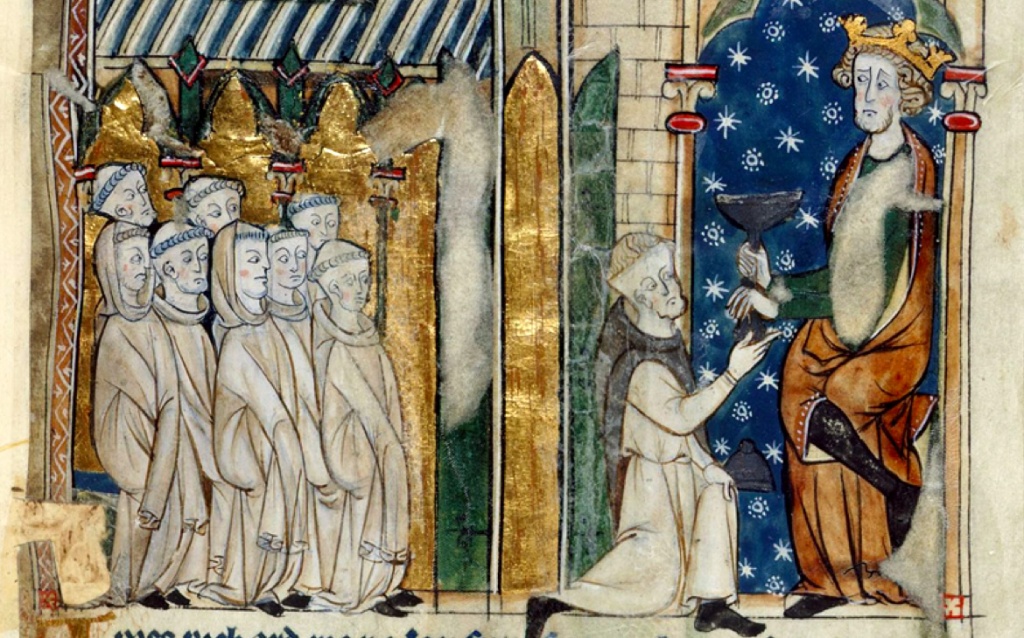King John reigned from 1199 until his untimely death in 1216. He was deeply unpopular – some forty years later the chronicler Matthew Paris wrote:
“Foul as it is, Hell itself is made fouler by the presence of John.”
John is also remembered as the king whose barons humiliated him by forcing him to agree to Magna Carta, the great charter of liberties that imposed limits on the power of the sovereign. That was on 15 June 1215. But less than two months later, the wily king secured an annulment of the charter’s terms from Pope Innocent III, and the First Barons’ War broke out.
This was in the time of the first of the Rochfords of Fenne – Waleran de Rochford – who sided with the rebels, like many of his neighbours and close associates.
All Waleran’s and his associates lands were confiscated, and on 22 April King John demanded that Waleran hand over his son Robert as a hostage.[1] This was very serious news. The king had a (justified) reputation for extreme cruelty, and it was probably known that he was not above deliberately starving his hostages to death. So, it is unsurprising that six days later, Waleran had still not handed over his son, while King John complained that he was “with the enemies of the king”.[2]
A month later, on 21 May, Prince Louis of France invaded England on the invitation of the rebels. In mid-September King John headed north to separate the rebel-held areas of Lincolnshire and East Anglia, arriving at Lincoln on 22 September and then Boston on 5 October. From there the king headed fifteen miles southwest to Spalding and then, a few days later, 25 miles west to King’s Lynn, where he is said to have contracted dysentery. After a few days, the king departed for Newark on Trent, taking the long route around the fenlands of The Wash via Wisbech, Swineshead and Sleaford, where his sickness took hold.[3]
Meanwhile the royal baggage train had taken the direct route through the fens, where the king’s crown jewels were famously lost in a tidal estuary. It is surely no coincidence that this route passed through the homelands of Waleran’s close associates and co-rebels, Conan son of Ellis, William de Holbeach and others. Their men would have had good reason to plot and disrupt the king’s business.[4]
King John reached Newark Castle on 16 October, and he died there on the night of the eighteenth or nineteenth. It is impossible not to consider whether he was murdered, or given tainted food and water – possibly with the connivance of Waleran or one of his colleagues. At the time, it was rumoured that a monk of Swineshead Abbey had offered the detested king a poisoned chalice, as depicted in the 1200s illumination at the top of this post.[5]
You can read more about death of King John in this post from the British Library.
Meanwhile, Waleran de Rochford was gradually rehabilitated under the reign of Henry III. Between 1218-1222 the new king’s travelling Justices in Eyre crisscrossed the country hearing cases and re-instating the rule of law. The justices who arrived in Lincolnshire around 1219 were particularly conscious of the nobility of their cause; they wrote that they intended:
“For the peace of the king and the kingdom, to give justice to each and everyone, poor as well rich”.[6]
Waleran de Rochford was appointed as a jury knight to number of the Lincolnshire cases,[7] although his debt to the crown “for having the grace of king John” would remain for the rest of his life.[8]
You can read more about Waleran’s life here.
Footnotes
[1] Rotuli de Oblatis et Finibus, p594, https://books.google.co.uk/books?id=Cf49AAAAcAAJ&pg=PA594
[2] Rotuli Litterarum Patentium, v1 part 1, p179, https://books.google.co.uk/books?id=uk4MAQAAMAAJ&pg=PA179&q=rocheford
[3] Church, ‘King John’s Testament and the Last Days of his Reign’, English Historical Review, http://worcestercathedral.co.uk/media/King_Johns_Testament_by_Prof_Stephen_Church2.pdf; The Itinerary of King John & the Rotuli Litterarum Patentium, http://neolography.com/timelines/JohnItinerary.html
[4] Rotuli de Oblatis et Finibus, p593-4, https://books.google.co.uk/books?id=Cf49AAAAcAAJ&pg=PA593; Strickland, War and Chivalry: The Conduct and Perception of War in England and Normandy…, p91, https://books.google.co.uk/books?id=rrm0lnqPep4C&pg=PA91; Rotuli Litterarum Patentium…, p196, https://books.google.co.uk/books?id=uk4MAQAAMAAJ&dq=walannus%20de%20rocheford&pg=PA169
[5] BL Cotton MS Vitellius A XIII
[6] David Carpenter, The Minority of Henry III, pp99-100, etc, https://books.google.co.uk/books?id=93nNNQUyFwAC&pg=PA99
[7] Rolls of the Justices in Eyre for Lincolnshire (1218-1219) and Worcestershire (1221), p231, http://books.google.co.uk/books?id=4-8yAAAAIAAJ&q=%22waleran+de+rupe+forti%22
[8] Pipe Rolls, https://books.google.co.uk/books?id=MWZnAAAAMAAJ&q=talebot; Pipe Rolls, https://books.google.co.uk/books?id=MWZnAAAAMAAJ&q=”waleram+de+rocheford”
